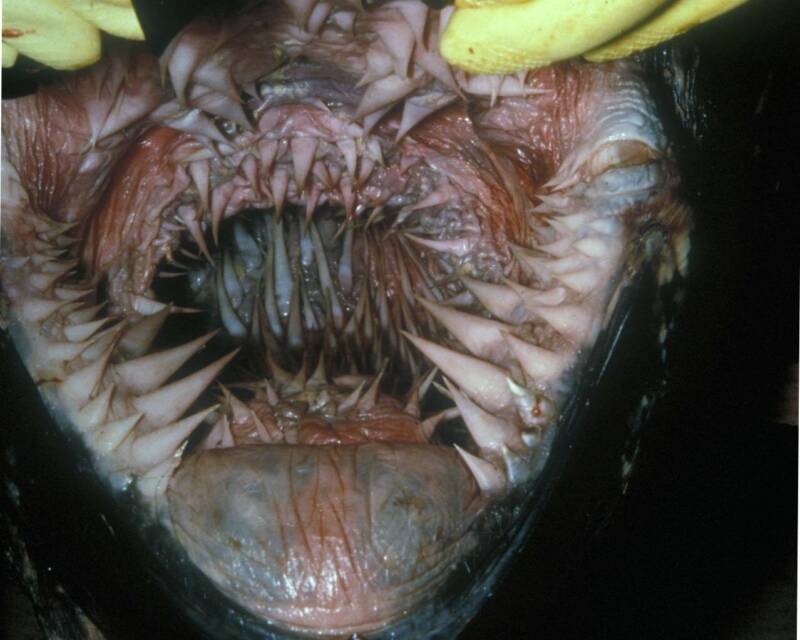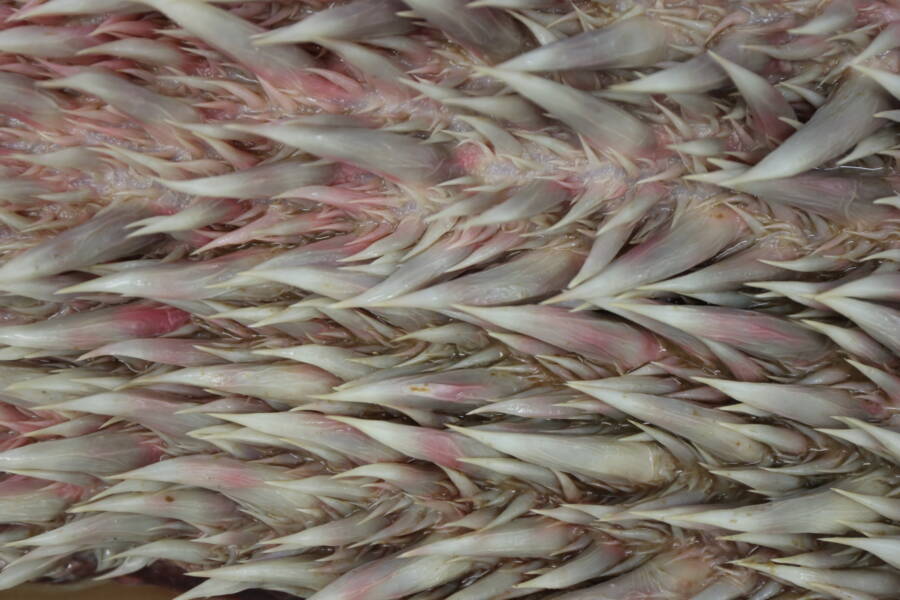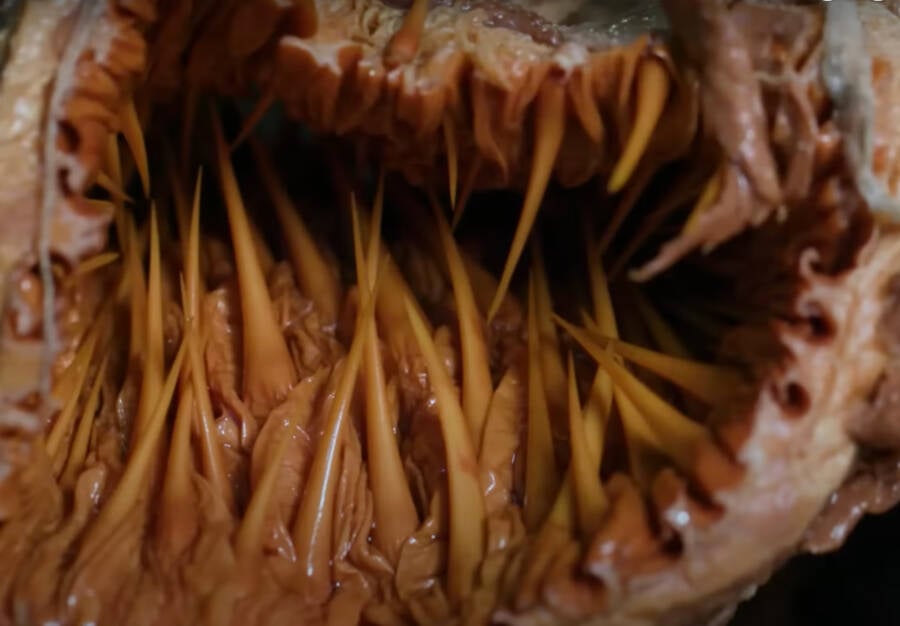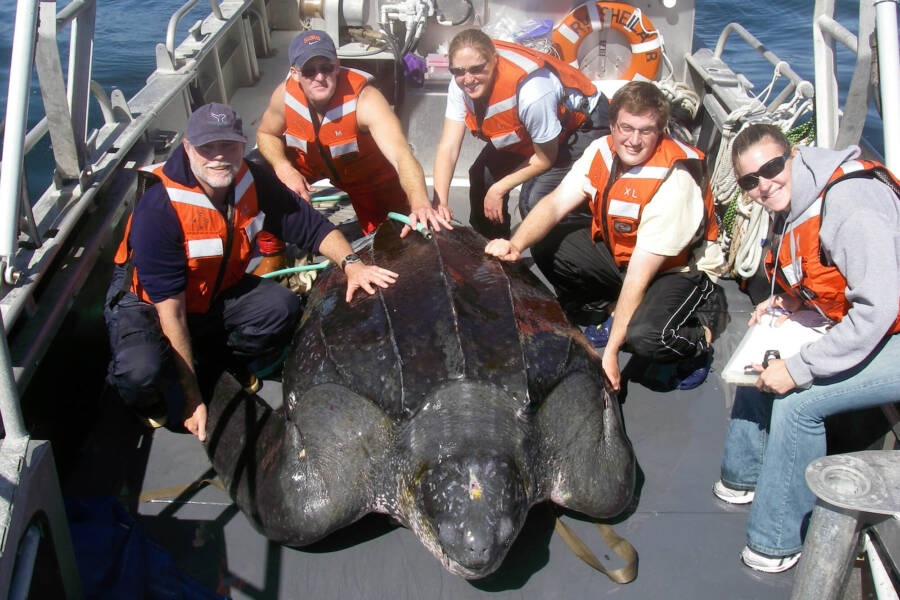Leatherback sea turtles eat by swallowing water along with their prey, then vomiting up the water while the spikes in their mouths prevent the prey from escaping.

RedditThe mouths of leatherback sea turtles as well as loggerheads and green sea turtles are lined with spikes that allow them to feast on hundreds of jellyfish per day.
Have you ever seen the inside of a sea turtle’s mouth?
Sea turtles are beloved creatures, often portrayed as gentle and laid-back in popular culture, but the mouths of sea turtles, especially leatherbacks, reveal a much more nightmarish side. Unlike land turtles, sea turtles like the mighty leatherback have sharp, spiny structures called papillae lining their throats that look like something out of a horror movie.
While these spikes inside sea turtles’ mouths aren’t teeth, they do play a crucial role in helping them hold onto food in the water and safely consume dangerous prey like jellyfish. The papillae extend all the way down a sea turtle’s esophagus, preventing food from escaping when water rushes into their mouths.

PixabayA loggerhead sea turtle swimming in the ocean.
Though these structures in leatherback sea turtles’ mouths are a vital adaptation, they can’t protect them from their biggest threat: ocean pollution. Necropsies conducted by scientists have not only revealed the eerie papillae of sea turtles, but also the impact of plastic pollution. Items like balloon fragments, plastic bags, and lobster claw bands mix with their natural diet of jellyfish and sea plants, poses a serious risk to sea turtles’ health and survival.
These necropsies have not only shocked the world with their horrifying images, but also revealed how human activity is endangering sea turtles — giving us a stark reminder of the urgent need to address the pollution crisis in the world’s oceans. Turns out the insides of sea turtles’ mouths are disturbing in more ways than one.
Why Are The Mouths Of Leatherback Sea Turtles So Bizarrely Terrifying — And How Do They Work?

Wikimedia CommonsThe hard papillae that line a leatherback sea turtle’s mouth, as pictured during a necropsy.
Sea turtle species like leatherbacks, loggerheads, and green sea turtles, contain spikes in their esophagus called papillae, and though they’re as sharp as they look, they’re not teeth.
Their primary purpose is to move food from the sea turtle’s mouth through its digestive system — which means that thresher-like tract extends all the way through a turtle’s esophagus, past its stomach, and to its rear. In a fully mature leatherback, one of the world’s largest turtle species, that’s eight whole feet of slimy skewers to contend with.
Why the spines? Land turtles, after all, don’t have an armory in their throats; they’re able to use esophageal muscles to move their food, just like humans do.

PixabayThe mouth of a snapping turtle — a land turtle who doesn’t need the papillae that line many sea turtles’ throats.
The trouble is that sea turtles don’t have the luxury of swallowing their food on dry land. Every time a sea turtle opens its mouth, water gushes in — and pours out, carrying any loose debris with it, including the sea turtle’s last meal.
Or it would, if the food weren’t tucked safely between the sharp papillae, slowly moving deeper and deeper into the turtle’s digestive system.

Natural History Museum/YouTubeThe papillae that line the mouth of the leatherback sea turtle.
The spines inside a sea turtle’s mouth also protect it from dangerous prey; jellyfish are the leatherback’s favorite snack, and it’s imperative that the turtle’s insides are shielded from stings by the hard spikes.
So once jellyfish, crustaceans, and sea grasses go in, they don’t come back out. That is, not unless the turtle ends up on the operating table.
How Sea Turtles’ Mouths Reveal The Grave Threats They Face

NOAA Fisheries Researchers crouched next to a leatherback sea turtle.
Laura Castanon, a scientist at the Woods Hole Oceanographic Institute (WHOI), took a shocking video during a post-mortem examination of a loggerhead sea turtle, a big-headed, hard-shelled species that typically reaches two to three feet in length.
Castanon was investigating how low temperatures affect the loggerhead’s internal organs, but the WHOI’s turtle dissections — a weekly occurrence — attract a range of curious scientists and undergrads, and not just because of the sea turtles’ mouths.
Their subjects are sea turtles who didn’t make it, despite the best efforts of the volunteers who regularly comb winter Massachusetts beaches in search of cold-stunned creatures. Cape Cod typically sees around 600 stranded turtles every year, a result of the migrating turtles’ difficulty navigating the inlet.
Instead of continuing south to warmer waters, the sea turtles get confused while circumnavigating the bay and come to rest instead in brutally cold Atlantic currents. Their systems shut down as they’re forced to the shore — where volunteers are ready to perform turtle triage.
Many turtles are successfully revived, rehabilitated, and released after a spell in the warm waters of the nearby New England Aquarium.
But where rescuers fail, science steps in to learn what it can from the bodies — always hoping that the turtle necropsies will lead to better information about the threats endangered sea turtles face.

Coast Guard Compass Archive / Coast Guard Petty Officer 3rd Class Tyler McGuinnessThe Coast Guard releases a sea turtle into the Atlantic Ocean in 2017.
Unsurprisingly, humans rank among the gravest hazards.
The sea turtles’ mouths and spiny digestive tracts tell a sad story. In between shreds of sea plants, pieces of jellyfish, and snail bits are plastic fragments: torn balloons, the bands from commercial lobster claws, and scraps of shopping bags.
The dissection teams at WHOI know what’s really scary about the mouths of sea turtles: the evidence they contain of an increasingly plastic ocean — a danger to sea life everywhere.
The growing problem of ocean pollution presents a new challenge that even these ancient creatures aren’t equipped to handle. As plastic infiltrates their diets, the disturbing truth revealed by necropsies is a reminder that the fight to protect sea turtles — and the marine ecosystem as a whole — is far from over.
After this look into the mouth of the leatherback sea turtle, see some of the scariest sea creatures on Earth. Then, read up on the fear of the ocean known as thalassophobia.





